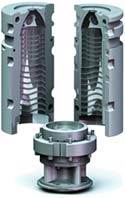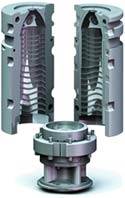How to Optimize Your ERP Implementation
Proven methodology for using enterprise resource planning.
Following a proven implementation methodology helps to ensure that an enterprise resource planning (ERP) implementation is on time, within budget and meets its objectives. An implementation methodology should include the following six steps:
1. Establish the right teams.
Start by setting up implementation teams that include people with the knowledge and authority to keep the implementation moving forward. These teams should include:
An executive committee to sponsor and oversee the project. It’s impossible to move forward productively without executive direction, decisions and buy-in. Implementation partners who have performed hundreds of ERP implementations say that establishing an executive committee responsible for steering the project is the number-one critical success factor.
A core project team to take ownership of the implementation, drive the project and train end users. One of the key benefits of an ERP solution is to automate and improve the efficiency of business processes. Line-of-business managers have the best knowledge of their functional area and business processes and have the best understanding of how the software should be configured and implemented to meet their needs. This project team should include managers for all the business units that will be impacted by the implementation—such as customer service, logistics, finance and manufacturing as well as an overall project manager.
2. Review business goals.
Organizations typically define business goals for the ERP implementation during the process of developing the business case for the ERP system. Common goals implementing ERP solutions include:
Empowerment and improved efficiencies for end users as they perform transactions though the ERP solution’s ability to offer automation, better access to information and end-to-end integration of business processes.
Faster and higher-quality business decisions. As end users enter data more efficiently, the summarized information needed by management and executives becomes more accessible, timely and meaningful.
Greater employee engagement. As employees become more productive due to the operational efficiencies from the implementation, employees can use their time performing more strategic and meaningful activities. This helps organizations retain employees.
Become closer with business partners, customers, suppliers in order to be more proactive by optimizing and shortening business processes. As the implementation begins, organizations should review these goals, incorporate any changes in thinking since the development of the business plan and keep these goals in mind as they proceed with the implementation.
3. Understand what the software can do.
The organization should have examined the features and functionality of the software when it created the business plan and selected the ERP solution. Now the implementation team needs to gain a more in-depth understanding of what the software can do by undergoing an introductory training. This helps the team better understand what is possible to accomplish using the software.
4. Define business processes to improve.
The key benefit of an ERP system is automating and streamlining business processes. Processes tend to evolve over time, rather than from a conscious effort to constantly reexamine and improve them based on their strategic value. While an ERP solution in and of itself won’t improve business processes, an ERP implementation is the perfect opportunity for functional implementation teams—often with the help of an implementation partner with experience in their industry—to carefully review how the organization currently performs business processes and then determine ways to use the functionality and best practices built into the ERP system to streamline and improve these processes.
Typically, organizations define the processes they wish to improve when they develop their business case. However, during the implementation process, they should confirm that the processes defined in the business case are the ones that need to be improved and make sure they don’t miss any processes that should be improved. A systems implementation advisor may also be able to provide recommendations on improving business processes based on best practices from other customers.
This analysis lays the foundation for how the ERP software will be configured and ultimately used.
In some cases, organizations will be able to streamline their processes by simply using ERP best practices out-of-the-box or by configuring it within parameters available in the software. Many software packages designed for small to mid-size businesses are highly configurable. In other cases, when a business process is a competitive differentiator for the organization, the organization may need to customize the software to manage and automate these unique business processes. An ERP solution that comes with an integrated 4GL development environment can speed and simplify this customization process.
5. Consider implementation options.
On-premise: With an on-premise approach, organizations purchase a software license as well as the necessary hardware, and then implement and maintain the system in-house. Because on-premise solutions are installed on the customer’s servers and customers actually own the software, customers can customize the software and integrate it with their other software. This provides organizations with greater control over their business processes as well as over their business data. Additionally, over a long period of time, the total costs will be cheaper than an on-demand solution.
When implementing an ERP system in-house, organizations can do so incrementally or using a big-bang approach where the entire system is implemented and rolled out at once. Larger companies often use a phased approach because they tend to have many stakeholders and many different subsidiaries and departments that need to implement the system. However, small- to mid-sized organizations that want to derive a rapid ROI for their ERP investment by implementing the system quickly typically prefer a one-phased approach. Because today’s advanced systems are based on parameterization, systems designed for this market are highly configurable, facilitating faster, easier implementations.
On-demand: Another option for organizations desiring a rapid implementation is to subscribe to a cloudbased (Software as a Service—SaaS) ERP solution. With cloud-based ERP, customers do not need to purchase a software license up front, install the hardware infrastructure and application on site or maintain and upgrade the solution. Instead, the solution is hosted and available via the cloud on a pay-as-you-go basis. This model eliminates the need to purchase the hardware or own the software. The on-demand approach has an advantage in not requiring a large up-front investment. However, because ongoing monthly costs are higher than an on-premise implementation, over a longer period on-demand solutions will be more expensive than an on-premise solution.
Another advantage of a cloud-based implementation for small to mid-sized businesses is that these solutions can be implemented faster in weeks versus months with fewer IT staff and low hardware maintenance. This allows small to mid-sized businesses to start achieving the benefits from the ERP much sooner. In addition, applications are delivered as needed. Cloud computing provides greater deployment flexibility, enabling organizations to tighten the alignment between business strategy and the technology needed to achieve it.
When choosing between an on-premise or an on-demand implementation, organizations should look at their particular requirements—including the complexity of their business and business processes, size of their company, number of employees, expected business growth, and the sophistication of their IT skills and infrastructure.
6. Train end users.
An ERP solution will provide no return if users are unable to use it effectively—or don’t use it at all. The functional teams will therefore need to train end-users on the new system. An ERP system that includes an intuitive, easy-to-use interface will allow organizations to get employees up to speed more quickly and cost effectively.
Contributor:
As executive vice president of product strategy and marketing of Sage Business Solutions, Himanshu Palsule is responsible for directing product strategy and marketing across a range of award-winning products, including the company’s ERP, entry level accounting, CRM, and vertical industry solutions. In prior roles at Sage, Mr. Palsule has been the general manager of the division’s specialized solutions business and its ERP and CRM products across Sage North America. He has more than 20 years of experience in the accounting and financial industry and has been a regular speaker at several industry events. He holds a degree in computer science from India and a degree in software engineering from the University of Minnesota.
For More Information:
Sage ERP
(866) 530-7243
sageerpsolutions@sage.com
www.sageerpsolutions.com
Related Content
How to Select a Mold Temperature Controller
White paper shares how cooling channel analysis, which collects maximum pressure drop, total flow rate and heat dissipation, eases the performance evaluation of mold temperature controllers.
Read MoreWhat Is Scientific Maintenance? Part 1
Part one of this three-part series explains how to create a scientific maintenance plan based on a toolroom’s current data collection and usage.
Read MoreTolerancing in Mold Design, Part 2: Using GD&T to Address Conventional Tolerancing Issues
Mold designers can achieve a single interpretation of workpiece functionality when following the American Society of Mechanical Engineers Geometric Dimensioning and Tolerancing standard.
Read MoreOEE Monitoring System Addresses Root Cause of Machine Downtime
Unique sensor and patent-pending algorithm of the Amper machine analytics system measures current draw to quickly and inexpensively inform manufacturers which machines are down and why.
Read MoreRead Next
Using ERP for Better Decision-Making
It has become more essential to know exactly what is going on in your business—not last year, not even last month—but at this very moment.
Read MoreHow to Use Strategic Planning Tools, Data to Manage the Human Side of Business
Q&A with Marion Wells, MMT EAB member and founder of Human Asset Management.
Read MoreHow to Use Continuing Education to Remain Competitive in Moldmaking
Continued training helps moldmakers make tooling decisions and properly use the latest cutting tool to efficiently machine high-quality molds.
Read More









.jpg;maxWidth=300;quality=90)











